
Being a pedestrian in the US was already dangerous. It’s getting even worse.

Part of the July 2022 issue of The Highlight, our home for ambitious stories that explain our world.
Drive along this part of US-19, a stretch of highway in Pasco County that parallels Florida’s Gulf Coast, and you’d be forgiven for not noticing the danger. It looks like a lot of American roads, especially in the South: flat, straight, and wide. Three lanes move in each direction, and extra turn lanes on the right and left bring the total number of lanes to eight or nine at most intersections. The road runs through several cities and places — Hudson, Port Richey, New Port Richey, and Holiday — but because of all the sprawl, you never really feel like you’ve left town.
Along the road is a panoply of American consumerism: Walmart, Publix, tattoo parlors, chain hotels, motels, 7-Elevens, multiple Dunkin’s, medical equipment stores, condemned buildings, strip clubs, auto body repair shops, oil change places, custom paint job businesses, chain restaurants, deserted property waiting to be redeveloped, and a mini-golf course where you can feed baby alligators, fenced in near the sidewalk.
Walk along this road, and you might begin to notice the danger. The speed limit is 45 to 55 miles per hour, but the cars are often going much faster. The crosswalks are so few and far between that a simple act — crossing the street to get to a business a few hundred feet away — might mean walking over half a mile to reach the nearest crosswalk. Even with sidewalks set back from the road, it’s clear that US-19 wasn’t built for pedestrians.
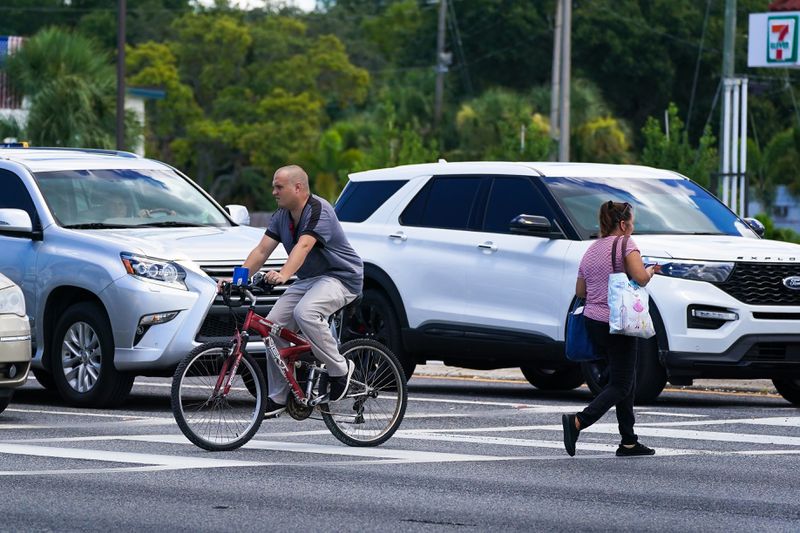

Robert Schneider, a professor of urban planning at the University of Wisconsin Milwaukee, has never driven on this part of US-19. But amid a rise in pedestrian deaths across the country, Schneider and three of his colleagues — Rebecca Sanders, Frank Proulx, and Hamideh Moayyed — decided to look at the data on pedestrian deaths to try to find out where they were happening most frequently. Using information from the government’s database of fatal car crashes, the Fatality Analysis Reporting System, Schneider and his colleagues looked at all the pedestrian deaths recorded between 2001 and 2016. The idea was to identify hot spots: 1,000-meter segments of roadway where six or more pedestrians were killed over two eight-year periods. “We thought: What can we find out about the places where these fatalities happened?” Schneider says. There would likely be similarities, he assumed, which could point to potential safety improvements. “One thing we wanted to shed light on is that they truly aren’t random.”
They were expecting to find some overlap. But one road came up so many times that the results, Schneider says, were “eye-popping.” Out of the 60 hot spots they identified as having a high number of deaths, seven of them were on US-19 in Pasco County alone — more than any other road in the United States. “When you add the numbers up, that’s 137 pedestrian fatalities over the entire Pasco County. That’s an incredibly high number,” Schneider says. “If an airplane crashed there and 137 people died, people would know about it,” he says.
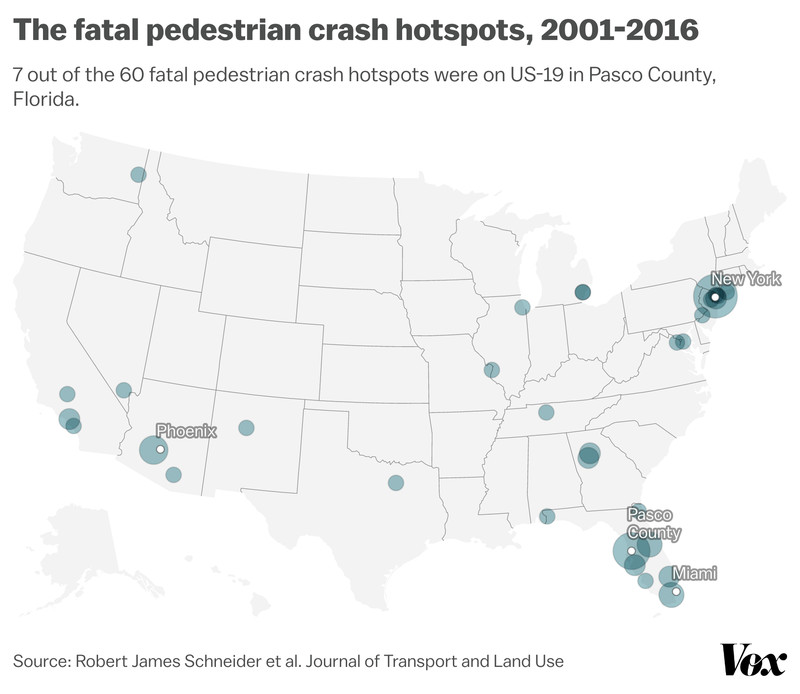
Youyou Zhou/Vox
The study looked at deaths through 2016 — the most recent year finalized data was available. But a Vox analysis of open-source data from the Florida Department of Transportation showed that pedestrian fatalities have continued to be a problem: 48 people have been killed in car crashes that involved pedestrians on US-19 in Pasco County between 2017 and June 2022.
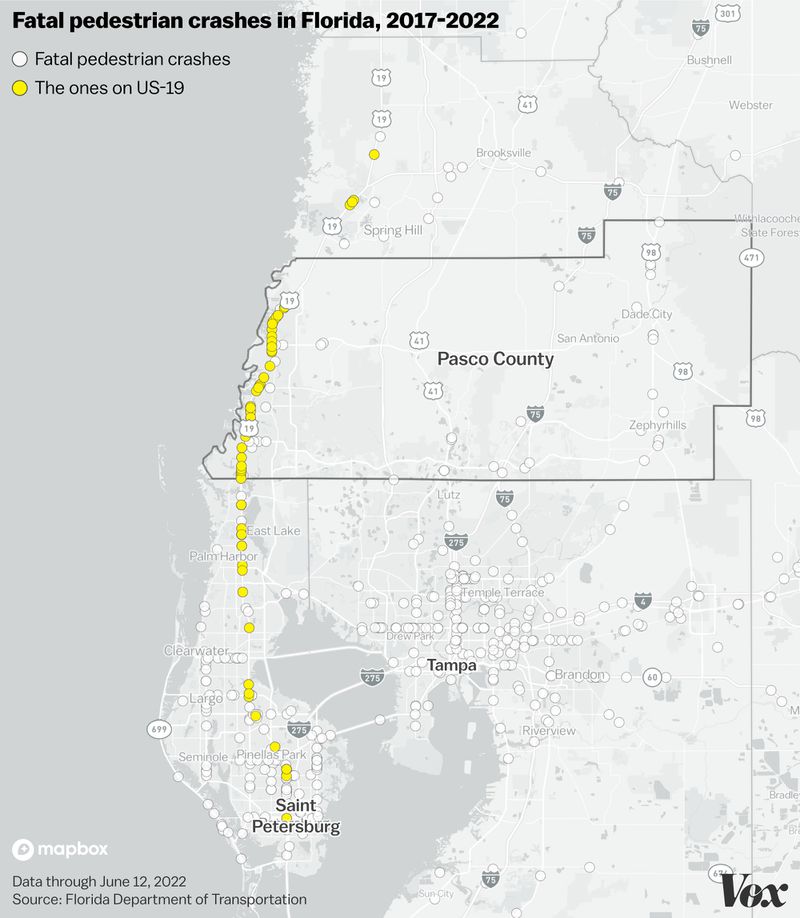
Youyou Zhou/Vox
For every 100 miles on US-19, there have been at least 34 deaths since 2017, making it the deadliest road across the state.
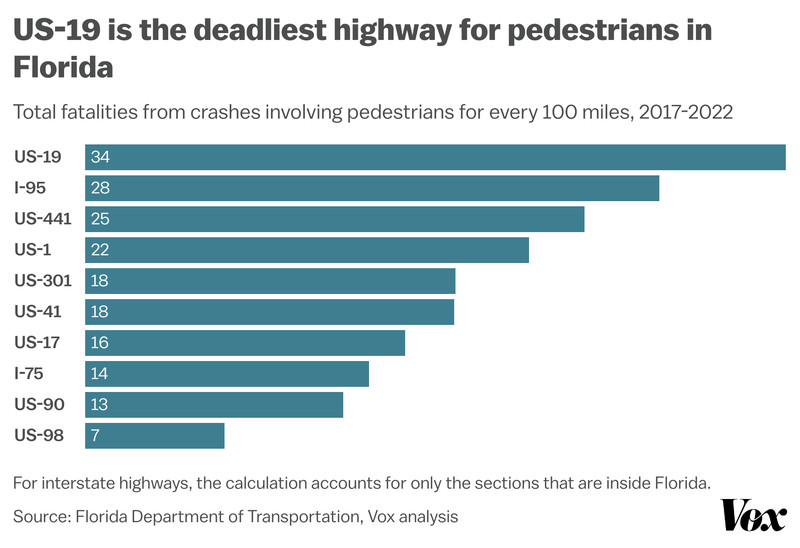
Youyou Zhou/Vox
Locals might not have the statistics at their fingertips, but they know that US-19 is dangerous. In 2020, 13 people traveling US-19 by car in Pasco County were killed in crashes. For residents who rely on it, US-19 is both mundane and maddeningly treacherous. Crashes are so ubiquitous that some talk about an old bumper sticker on cars that read: “Pray for me, I drive on US-19.” Another part of US-19, in neighboring Pinellas County, is sometimes called “death valley.” But the road is pretty much unavoidable for most people trying to move freely through the area, and the alternatives aren’t much better. No one is more endangered on the road than those who use it unprotected by a ton of steel — and there are a lot of them.
“This road has so many cars,” says Julie Bodiford, a nurse who lives in the area, “and it’s death after death.”
Julie’s brother, Kevin Bodiford, knew US-19 well. He didn’t have a car and he liked to walk, so the 33-year-old traveled it often, to visit friends and to move between his extended family’s houses. Each morning, he met his mom for coffee at the 7-Eleven on US-19 and New York Avenue in Hudson; it was their daily ritual, the way he checked in with her to let her know that he was okay.
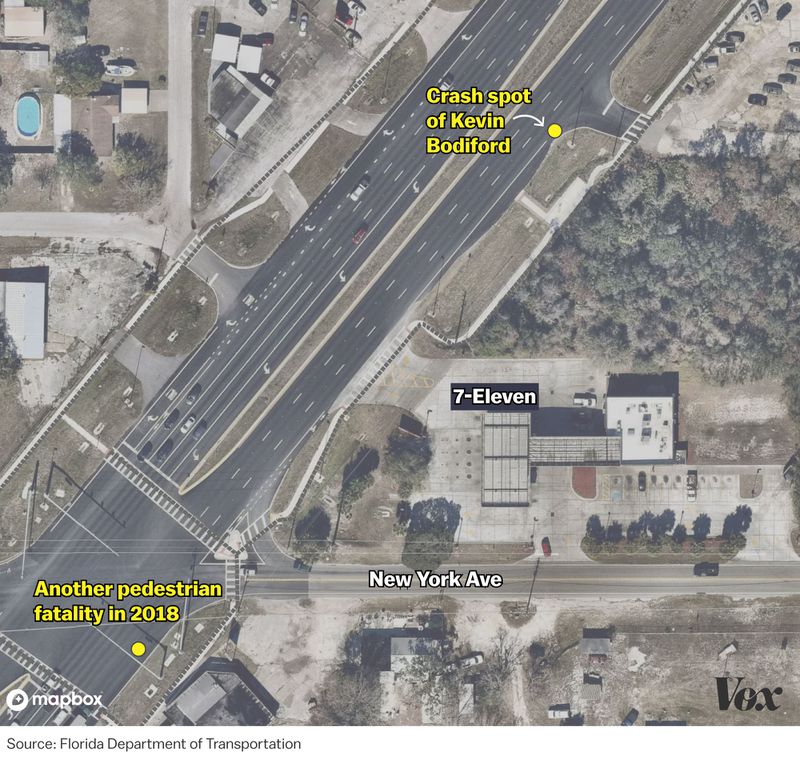
Youyou Zhou/Vox
Just after 2 am on June 10, 2021, Kevin was walking on the side of the road. Surveillance footage from the 7-Eleven shows him in a baby blue shirt, blue shorts, a UNC baseball cap, and a backpack. He’d been at a friend’s house for a bonfire earlier in the night; Julie thinks he was headed for their mom’s house.
In the official crash report from that night, the police said that Bodiford was trying to cross the road. The footage Kevin’s family obtained from a nearby business is grainy, but it shows something else: Kevin walks, and a truck towing a trailer passes him without incident. Then he appears to stop. Headlights illuminate his body. A white Chevrolet pickup truck plows through. In the video, Kevin is there one moment and gone the next. He was thrown from the road. His backpack was knocked off. The driver tapped the brakes and drove off, leaving Kevin to die on the side of the highway.
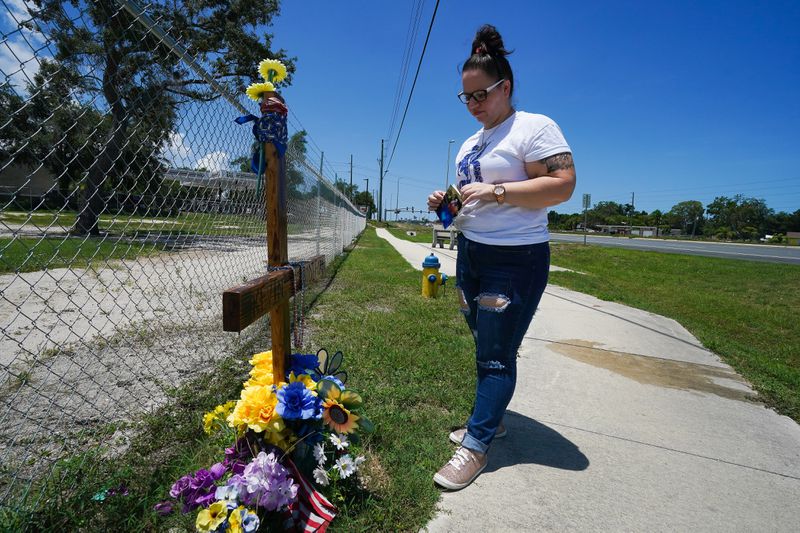
Because life in the United States is so structured around cars — so many of us depend on them, due to sprawl and lack of good public transit, and because infrastructure in this country is built with drivers in mind — it can be easy to miss the broader crisis unfolding on our streets. Most of us, when we drive, tend to think about our experiences as specific; our roads might have horrible traffic, or our community’s drivers might be particularly reckless. But the evidence mounting over the past few years indicates that something much larger is going on: America is experiencing a pedestrian fatality crisis.
It’s not just Florida. In 2020, more than 6,700 pedestrians were killed while walking and using wheelchairs, despite a dramatic decrease in the number of cars on the road and the number of miles traveled. Data from the Governors Highway Safety Association that year projected that the pedestrian fatality rate soared 21 percent, amounting to “the largest ever annual increase in the rate at which drivers struck and killed people on foot.” That same year, nearly 39,000 people were killed in car crashes, the largest number of deaths since 2007. When the National Highway Traffic Safety Administration released its preliminary findings, the NHTSA’s deputy administrator told Reuters: “We’ve never seen trends like this, and we feel an urgency ... to take action and turn this around as quickly as possible.”
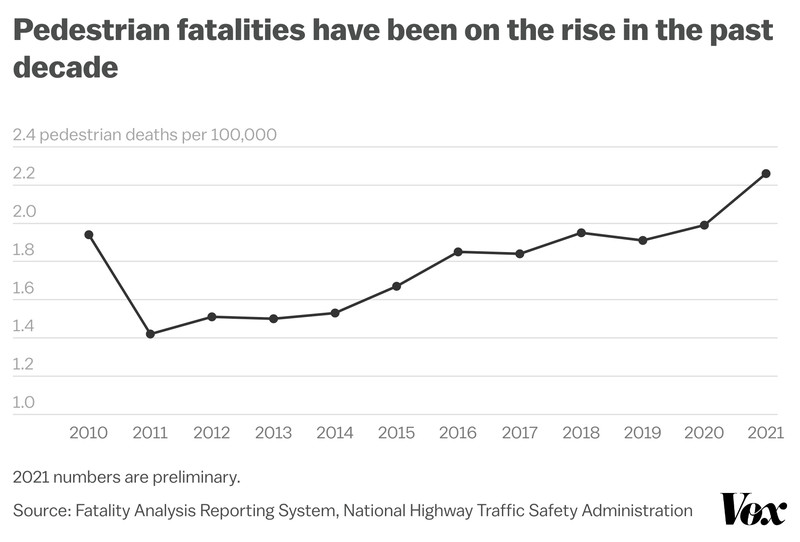
Youyou Zhou/Vox
In 2021, the problem managed to get even worse. Preliminary data from the Governors Highway Safety Association found that 7,485 pedestrians were killed by drivers, an 11.5 percent increase over the year before, and the most pedestrian deaths recorded in nearly 40 years. In response to the rising death toll among pedestrians and drivers, the US Department of Transportation announced more than $5 billion in funding for local efforts to make roads safer. “We face a national crisis of fatalities and serious injuries on our roadways,” Transportation Secretary Pete Buttigieg said in making the announcement this May.
We are so inured to the dangers of driving — and the death toll it regularly incurs — that many people don’t recognize that the United States is an outlier among comparable countries: People are more than twice as likely to die in an automobile crash here as in Canada or parts of Europe.
In Florida, which has long been one of the deadliest states to be a pedestrian, 716 people were killed walking on roads and streets in 2020. In 2021, the death toll reached 899, the highest numeric increase of pedestrians killed in any state. “The way to think about Florida is as a leading edge,” says Eric Dumbaugh, a professor of urban planning at Florida Atlantic University and associate director of the Collaborative Sciences Center for Road Safety. “Because there’s so much growth going on relative to other places, we see trends that happen nationally go on a lot faster here.”

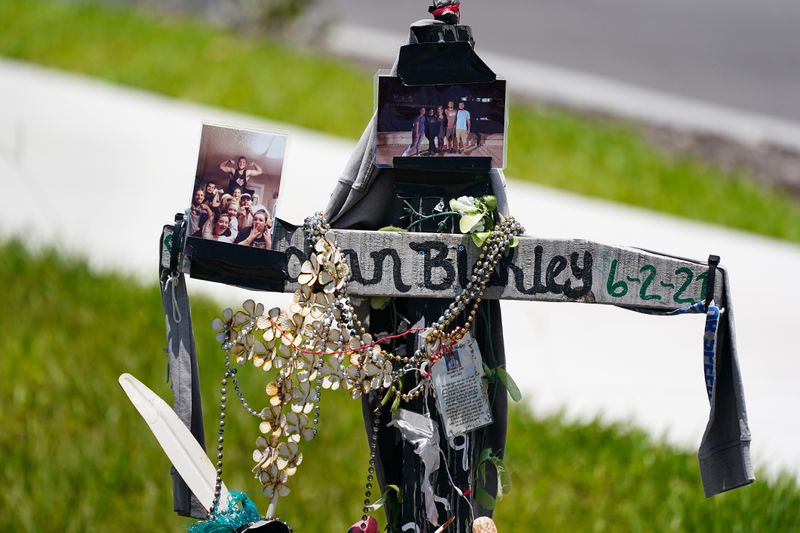
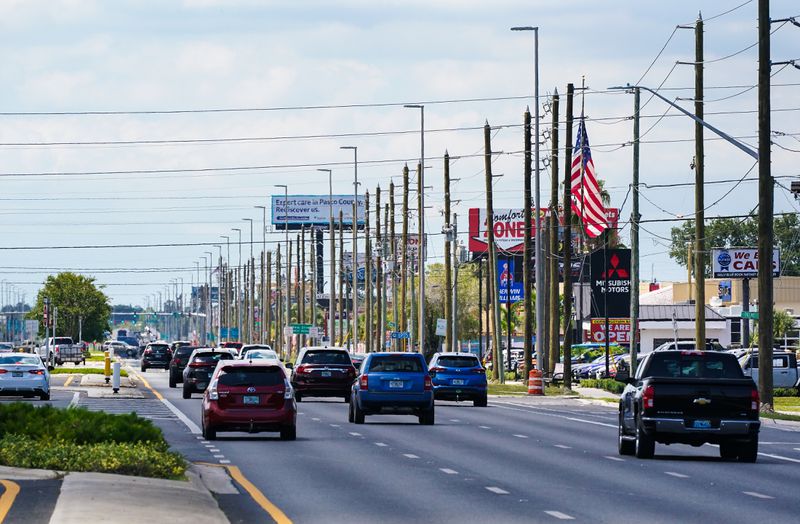
In 2011, state and local officials in Pasco County began meeting to discuss how they could make the road safer, following a national report indicating that the Tampa-St. Petersburg-Clearwater area, where the county is located, was the second most dangerous metropolitan area in the country for pedestrians (the top four were all in Florida). The state spent millions on improvements it said would help make the road safer. In 2018, according to the Tampa Bay Times, the state put another $100,000 into developing a new action plan to address the high number of deaths.
Last year, the Florida Department of Transportation (FDOT) installed crosswalks at some intersections that were missing them, added more sidewalks, built out curbs, installed LED streetlights, and handed out bright lights to people who travel the road by foot or bike at night.
“It’s a huge priority, for the state of Florida, to fix this issue,” says Kristen Carson, a spokesperson for FDOT.
It isn’t just US-19, though. In recent years, other roads in the state have also seen high numbers of pedestrian deaths. “US-19 may be worse,” says Dumbaugh, “but we’ve got a bunch of roads competing for that title.”
New Port Richey Mayor Rob Marlowe, who has lived in the area since 1963, says that years and years of deaths — and complaints from the locals who travel along US-19 — have done little to make it better. “US-19 is a problem, and it has been as long as I can remember,” Marlowe says.
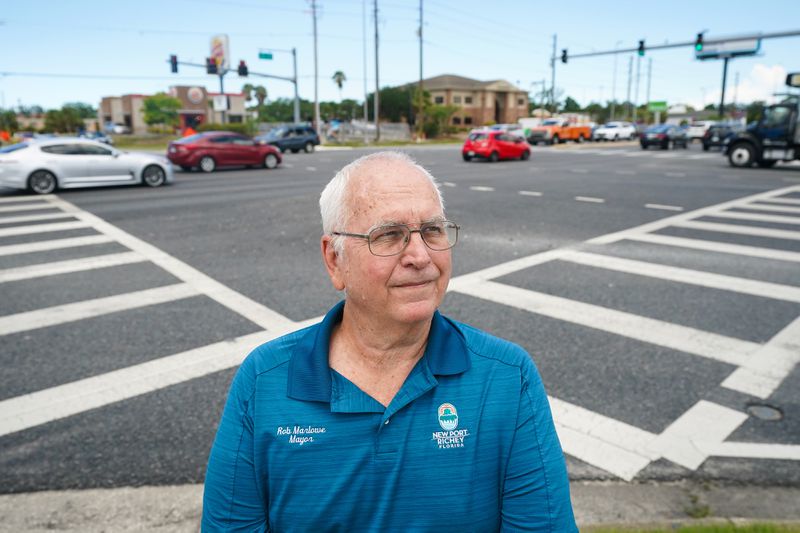
On an oppressively humid Thursday in early June, I meet Marlowe at his office, on the second floor of City Hall. He wants to show me what the streets look like in his community, so we get in his Tesla and drive around town, through New Port Richey’s central commercial district, where palm trees line the avenues, and its residential neighborhoods, where Spanish moss drips from trees shading colorful bungalows.
Everywhere, there are signs of roads designed without pedestrians in mind: residential streets that are needlessly wide, despite a lack of traffic, and sidewalks only wide enough for one person, if they’re present at all.
The problem, Marlowe says, “really took root back in the 1960s, as the area exploded in population.” Subdivisions sprang up along US-19, as developers anticipated a growing population of retirees who wanted to live cheaply and get around by car. In most cases, the only way to get from one subdivision to another, he says, was to get on US-19 — but back then, it was easier to navigate, because it was only a couple of lanes.
Marlowe pulls up to the intersection of Main Street and US-19 — the center of the deadliest hot spot in the country, according to Schneider and his colleagues’ study — where state officials recently built out the curb to provide a safe space for pedestrians trying to cross, and to slow down drivers coming around the bend. As we turn right onto the highway and head north, he tells me to be on the lookout for the next safe place to cross.
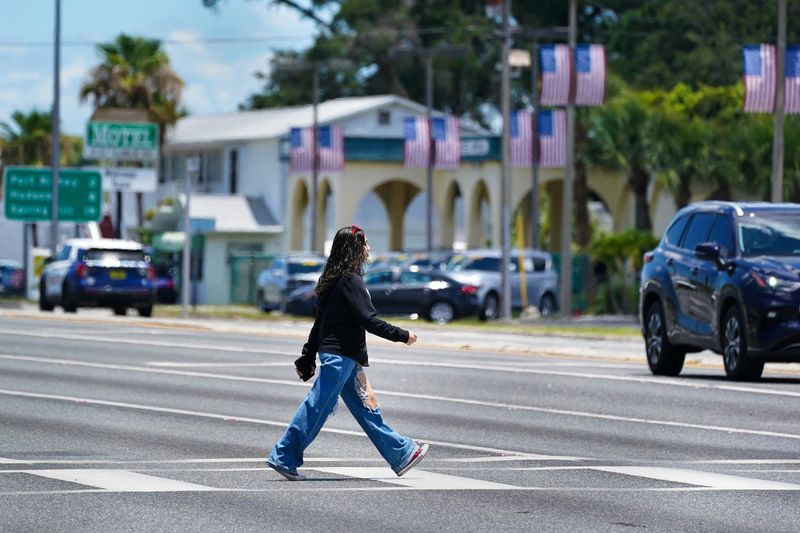
The crosswalks are so far apart it’s easy to see why some people decide to make a run for it. After Main Street, we don’t see another crosswalk until Grand Boulevard in Port Richey — 1.7 miles away. That means someone looking to get across the street between the two might need to walk an extra mile or more to find a safe crossing. The speed limit is 45 mph through New Port Richey, but Marlowe says it’s not uncommon to see people doing over 60 mph, making the road essentially a freeway with residential and commercial development on either side. “US-19 was designed for speed, and they” — meaning drivers — “use it that way,” he says. “The tendency seems to be to just go as fast as you can.” At night, the sheer size and width of the road make visibility a challenge (even with LED streetlights, which are meant to improve visibility), making it even more deadly for pedestrians who try to cross.
“The danger of US-19, and all highways, is in their design,” says Frank Starkey, who grew up in the area. Starkey founded a real estate development and consulting firm called People Places and worked closely with the mayor and other city officials on the revitalization of downtown New Port Richey. Part of the revitalization effort, both men agreed, required slowing down traffic on Main Street, so drivers were more likely to interact with local businesses, and pedestrians could move safely without fear of being hit by cars. But city officials aren’t responsible for US-19 — state officials are. “FDOT’s reason for living is to get as many people as possible, as far as possible, in the least amount of time. That’s their issue,” Marlowe says. “It may not be written that bluntly, but that’s it. In the case of Frank and myself, we’d like people to slow down.”
It’s a fundamental conflict, one that plagues communities like New Port Richey all over the country. State transportation departments, Dumbaugh, the urban planning professor, says, designed arterial roads to be high-speed and efficient ways of carrying lots of traffic. Land developers then built up property around the roads. “Once that happens,” Dumbaugh says, “you’ve put together a few things that are fundamentally incompatible.” Add more housing to the mix and you’ve got a situation where people are walking, Dumbaugh says, “in environments that were never designed to accommodate it.”
Julie and Kevin Bodiford were best friends, but they were more than that. They were only a few years apart in age, and they were alone a lot as kids, so Kevin was like her sidekick, her little brother, and her oldest son all rolled into one.
As kids, they’d get off the school bus at the end of the day and it would just be the two of them. They adapted to each other’s interests: Julie would play football with Kevin, who was a natural athlete, and he would agree to play Barbies and let her paint his nails with clear polish. Julie loved to sing and dance, so Kevin set up speakers and a microphone for her. “He was my roadie,” she says.
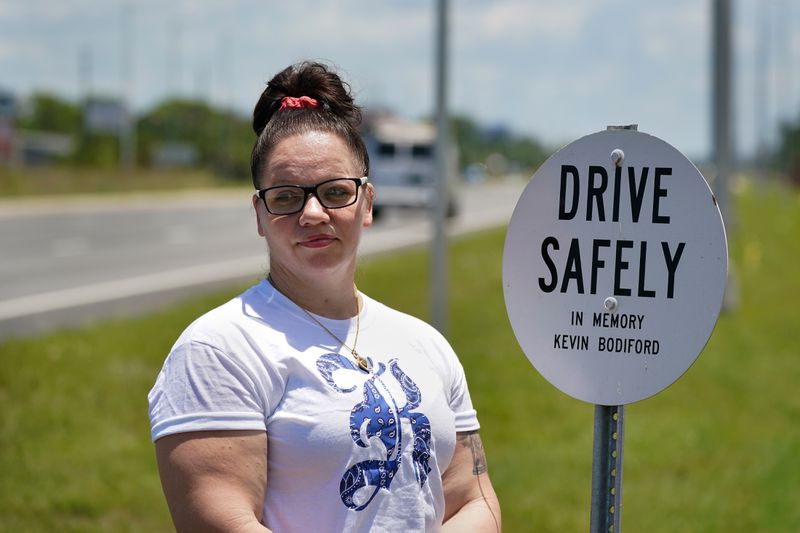

Kevin was the freewheeling one in the family. He was always operating at full volume, cracking jokes, reminding his more staid family members that life was meant to be enjoyed. He had been incarcerated on and off and sometimes struggled with mental illness. He was also a loving uncle, who tattooed his nieces and nephews’ footprints on his arm and delighted them by doing pushups with the kids on his back.
Growing up, Kevin was Julie’s protector — the person who made her feel safe. His strength sometimes made him seem invincible. Losing him in this way shattered Julie’s sense of security. She struggles with PTSD from what she experienced the night of his death, and the memories of her mom calling her, screaming that her brother had been killed. At the hospital, she remembers the police officer who came to confirm Kevin’s identity, and how pained and red his eyes looked as he asked to see her identification. The officers who responded to the scene that night were just down the road, dealing with another crash that killed a motorcyclist and two people in a car. Julie, a nurse, worries about how they handle the aftermath of these crashes.
“People just think, ‘Oh, it was just some guy,” she says. “Well, that ‘some guy’ mattered to a whole frickin’ family. You hit him and left him like a stray dog on the side of the road. Like it wasn’t a human life.”
When fatal crashes happen, the questions — from law enforcement, the media, commenters on Facebook — inevitably turn to human behavior: Was the driver drunk? What was the pedestrian wearing? Was the driver texting? How fast were they going? Was the cyclist wearing a helmet? What was the pedestrian wearing? Could they be easily seen in the dark? In other words, we look for ways to blame individual behavior, rather than consider the larger systemic forces at play.
That instinct, to attribute a fatal crash to some failure of personal responsibility, distracts us from the bigger picture: that many of our road designs are inherently unsafe. Jessie Singer, author of the book There Are No Accidents, says that the things we think of as “accidents” are in fact the result of dangerous conditions in our built environments. The reality is that the more vulnerable among us suffer the consequences more than others. People who are low-income, who are disadvantaged because of their race, their immigration or housing status, or their status as pedestrians in an environment built for cars, are more at risk of dying as a result.

We focus on individual blame, Singer says, because that makes it easier for us to believe that it couldn’t happen to us. Plus, it prevents us from having to make the hard structural changes necessary to prevent crashes from happening again: to call them accidents makes them seem at once inevitable and impossible to change. “This narrative kind of lets the government and corporations off the hook from having to protect us,” Singer says.
If accidents are supposed to be random, Singer says, “then accidental death would be evenly distributed across the country — but it’s not.” Schneider’s study showed that pedestrian deaths aren’t random, either. The places with the most pedestrian deaths tend to look like US-19 in one way or another: high-speed, with multiple lanes, and lots of commercial and residential development around them. Three-quarters of them are bordered by low-income areas, where people may be less likely to have access to a car. They are in places as diverse as Langley Park, Maryland; Albuquerque, New Mexico; Manhattan, New York; and Los Angeles, California. They’re places where pedestrians are forced to cross roads that are dangerous by design, alongside trucks and SUVs that are getting bigger and deadlier all the time.
A decade ago, Charles Marohn coined the term “stroad” to describe roads like US-19. Marohn, a professional engineer who used to work on road design, wanted a useful shorthand for a problem that has become a feature of many communities. A road, Marohn explained, is meant to move people as quickly as possible from one location to another, and engineers design them to be wide, with lots of lanes and clear zones on either side to make driver errors less deadly. Streets, on the other hand, are places: where people live, shop, eat, and play. Because streets are highly developed on either side, vehicle traffic needs to be slow, to accommodate people outside of cars.
A “stroad,” Marohn says, is the worst of both worlds. “If you think of a futon that’s trying to be both a couch and a bed and does neither of them well — that’s a stroad. A stroad tries to be both a street and a road at the same time, and it underperforms at both,” he says. Stroads are highly congested, with drivers stuck in stop-and-go traffic and turning across several lanes, and the potential for collisions increasing exponentially.
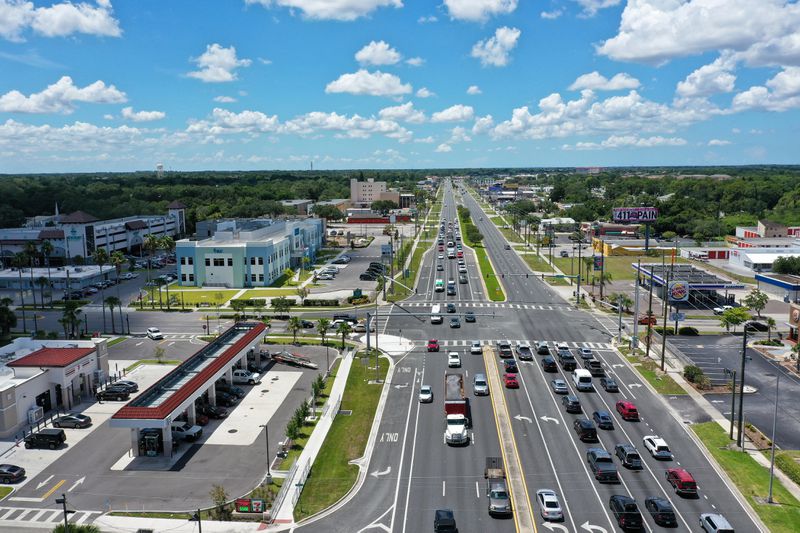
“Stroads are really deadly,” Marohn says. And US-19, with its high speeds, multiple lanes, cars turning on and off — and people walking, biking, and using wheelchairs — is kind of like a stroad on steroids. “This is literally the deadliest design that we could come up with,” he says.
Traffic engineers’ typical response to high congestion is to create more lanes for more traffic, Marohn says, which only makes the problem worse. Studies have shown that more lanes tend to create more traffic, which means that building out stroads usually results in the same amount of gridlock. What happens when engineers widen roads and create clear zones, Marohn says, is that drivers respond to those cues. “It tells drivers, we’ve got your back, and the way that drivers respond to that is by shutting off the active part of their brains,” he says.
Road design isn’t the only factor contributing to the increase in pedestrian deaths. Over the past 20 years, the size of SUVs and trucks sold for personal use has grown bigger and bigger — and those cars have proven more deadly for pedestrians and cyclists.
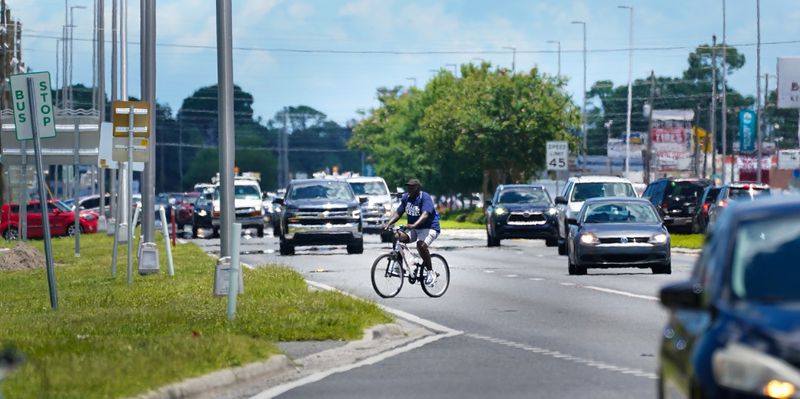
At the same time, the country’s housing crisis has created a larger population of people without homes, who are particularly vulnerable to being hit by cars.
Experts are still studying why pedestrian fatalities surged across the country during the pandemic, but some think the disruption to normal traffic patterns as Americans stayed home may have exacerbated the problem, because congestion is actually one of the few things that can force cars to slow down. “The congestion has in a sense been covering up our deadly designs,” Marohn says. “What the pandemic did is reveal how deadly our design approach is.”
Marohn thinks the fix is for local communities — not traffic engineers — to decide what they want a given road or street to be, and then to focus on meeting those goals, essentially deprogramming stroads so that they’re either streets or roads. It would mean slowing traffic way down to keep cars from moving through streets too quickly, or removing businesses’ driveway access to stroads and keeping pedestrians far from the road so they can become safe for high-speed travel.
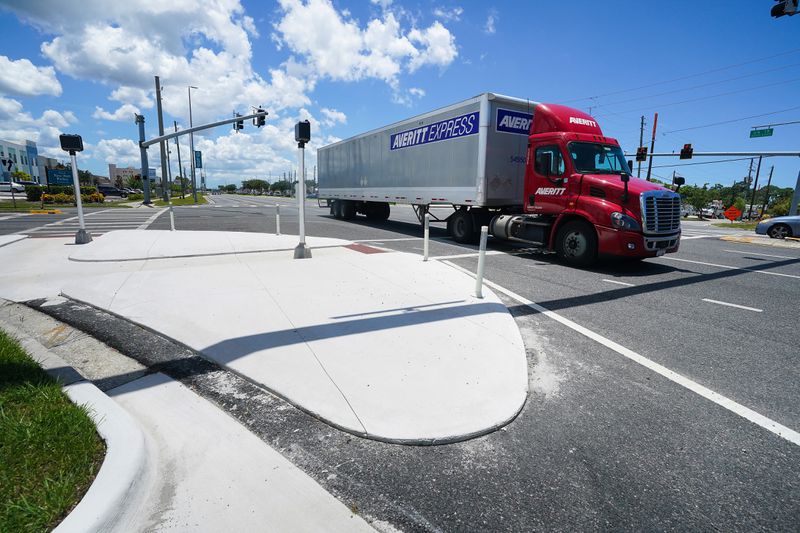
Pedestrian safety experts say there is a lot more we could do to ensure streets are safer for people outside of cars. Governments could improve public transit, investing in modes of transportation that are less deadly than driving, and install more traffic cameras to discourage speeding without creating more opportunities for deadly interactions between drivers and police. Car manufacturers could use speed limiting devices to slow cars down. States and local municipalities could design roads to be narrower, remove lanes, and use street design features such as chicanes, traffic circles, curb extensions, and speed humps to help calm traffic. Recently, thousands of advocates and officials across the country urged safety regulators to begin studying the safety of vehicles for people outside of the car as well as drivers and passengers.
“There are simple solutions here,” Singer says. But they require a shift in perspective, one that entails “not focusing on the last thing that went wrong and the last person who made a mistake, but accepting that mistakes are inevitable and premature death is not, and that we can put systems in place that prevent harm when we make mistakes.”
They are easy to miss at first, unless you’re looking for them. But then you start to see them everywhere: the roadside memorials for people killed along US-19. One day, I pull over to look at a memorial for Rhonda-Ann Grzyb, killed in a crosswalk in 2017. Driving a bit farther, I make a U-turn across three lanes of traffic to stop at another, for Matthew Francis Sands, killed trying to cross the road on foot in 2018. A short distance from there, down a sidewalk, partially flooded, is another for Kevin Michael Osborne, killed when his SUV collided with a Jeep Cherokee in 2007. After a certain point, it no longer feels safe to keep crossing multiple lanes of traffic for each stop, so I drive south across Pasco County toward Tampa and count the number of memorials I see. Over about 15 miles, I come across 12 more signs commemorating the dead.
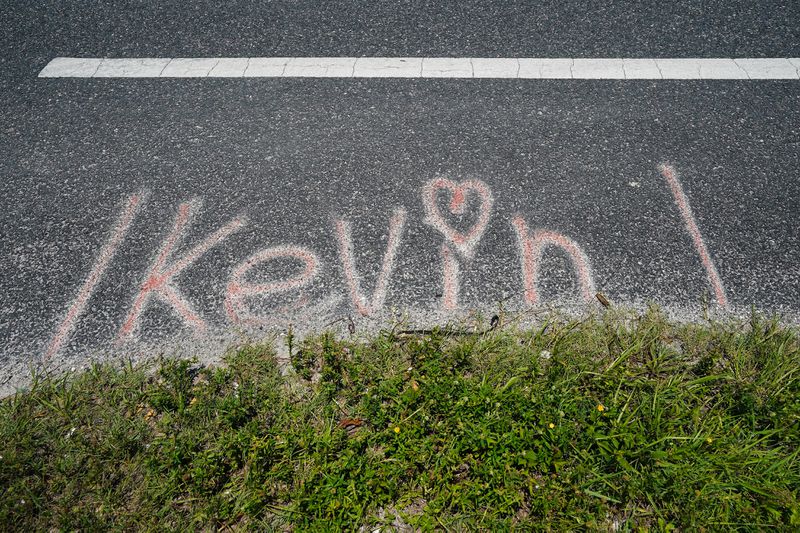
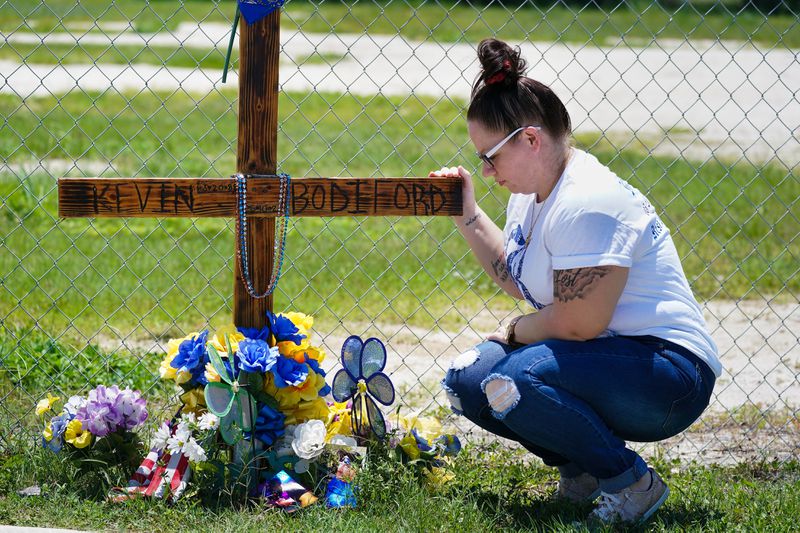
After Kevin Bodiford died, the family made a cross with flowers that they took to the spot where he was killed. At some point it was dug up — they’re not sure by whom — so they made another. The state also placed a memorial sign that says “Drive safely in memory of Kevin Bodiford” near the spot where he was killed. His brother spray-painted Kevin’s name on the road, close to two circles he painted, which outline the place where Kevin’s blood spilled.
The man who hit Kevin was arrested and is facing charges for leaving the scene; Julie thinks the family would have felt more forgiving if he had just stayed. Instead, they find themselves returning to court for hearing after hearing, hoping for some accountability for Kevin’s death.
The family didn’t really want to celebrate the holidays without him last year. When they gathered, his mom brought his ashes with her. Julie keeps some of them sealed in a heart locket she wears every day. She got a half-sleeve tattoo of a cardinal breaking free from a cage, to honor Kevin’s memory.
She has no real choice but to keep driving the road where her brother was killed.
On my final evening in Pasco County, I’m driving on US-19 past Main Street, where Marlowe took me earlier in the day, when I see a group of people gathered on the street corner near a gas station. Most of them look to be in their late teens and early 20s. Dusk is settling in, and big pink cotton-candy clouds glow to the west, over the water. I pull over and ask a group of young women what they’re doing. One woman, whose name is Jessie, tells me it’s the one-year anniversary of her boyfriend’s death. He was 21 and driving his car when a driver struck and killed him.
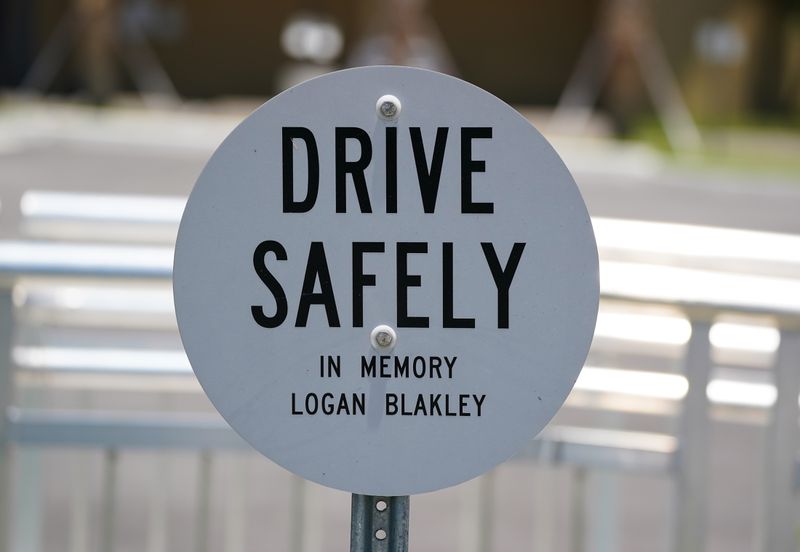
Jessie and her friends are from the area. US-19 has always been a part of their lives. It’s not just pedestrians; it’s perilous for drivers, too, they say. “It’s extremely dangerous,” Jessie says. “There’s been so many accidents.”
While we are talking, an ambulance screams past, its lights flashing. Jessie and her friends watch it drive by. One of them nods toward the vehicle. “That’s probably one now.”
Marin Cogan is a senior correspondent at Vox.
----------------------------------------
By: Marin Cogan
Title: The deadliest road in America
Sourced From: www.vox.com/23178764/florida-us19-deadliest-pedestrian-fatality-crisis
Published Date: Mon, 25 Jul 2022 11:51:06 +0000






